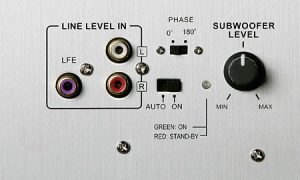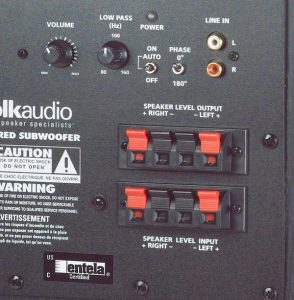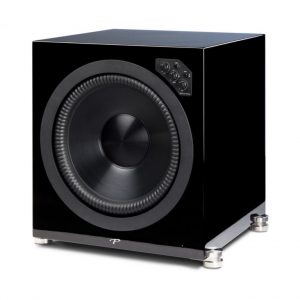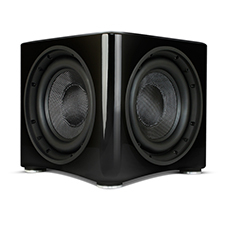11 Nov Sub Consciousness
Subwoofers have undergone a paradigm shift recently in how they are utilized by audiophiles, and the consensus is that they aren’t simply home theaterperipherals anymore. A nice tight sub can really improve the sound of your two channel HiFi system when it is properly selected and set up. Some of the factors that can influence that decision making include; your current amp & preamp, speaker size, speaker response, room size, desired purpose (home theater/two channel), and how the listener uses their system. This article is going to discuss the features and benefits of different subwoofer designs and the ideal applications for them.
 Generally, home theater processors and integrated audio visual receivers feature a single ended RCA subwoofer output. This output is usually attenuated by an internal crossover within the unit. Basically, inside of the graphic user interface there are settings for what frequencies the speakers and subwoofer/s roll off at. This is labeled as a “LFE” input on the back of the sub. LFE, or low frequency effects, designate the 3-120 Hz section of the frequency band. By having the lower frequencies compartmentalized to the subwoofer, you are effectively reducing the workload of your front left and right speakers. If you intend to use any digital signal processing the LFE input is more desirable. LFE connections are great for home theater processors, but sometimes it’s a better practice to simply send full range signal to the subwoofer and having the sub’s crossover perform the roll off. There unfortunately isn’t a universally preferred way to set these up, so I would suggest trying both to find out which sounds better in your syst
Generally, home theater processors and integrated audio visual receivers feature a single ended RCA subwoofer output. This output is usually attenuated by an internal crossover within the unit. Basically, inside of the graphic user interface there are settings for what frequencies the speakers and subwoofer/s roll off at. This is labeled as a “LFE” input on the back of the sub. LFE, or low frequency effects, designate the 3-120 Hz section of the frequency band. By having the lower frequencies compartmentalized to the subwoofer, you are effectively reducing the workload of your front left and right speakers. If you intend to use any digital signal processing the LFE input is more desirable. LFE connections are great for home theater processors, but sometimes it’s a better practice to simply send full range signal to the subwoofer and having the sub’s crossover perform the roll off. There unfortunately isn’t a universally preferred way to set these up, so I would suggest trying both to find out which sounds better in your syst em.
em.
For two channel stereo systems a low level input, seen in the attached photo, is commonly how a subwoofer is connected to the amp/integrated amp. These low level inputs can take speaker cables directly out of your amplifiers speaker terminals, and send full range signal to the sub. They can also take mono or stereo RCA inputs at line level and send that full range signal to your sub. At this point the subwoofer’s floating crossover determines the roll off of the signal. There are of course exceptions, and some two channel stereo integrated amps and preamps now feature LFE subwoofer outputs, but this isn’t very common.
 Now that we’ve covered the different types of input connections for subwoofers, we can discuss the various designs of subs. Down firing and front firing subwoofers have an exposed driver that bellows it’s excursion in and out like a conventional full range speaker. These models make up the majority of subs on the market, and span a large spectrum of quality. Most home theater specific subwoofers fall into these categories. Some people prefer a down firing sub because gravity pulls the driver down evenly around the entire circumference of the driver’s surround. A front firing driver will stretch at the top and squish at the bottom over a long enough period of time, and eventually need to be re-surrounded. Band-pass subs have an internal driver that is not exposed, and project their sound through port holes in the cabinet. These band-pass subwoofers are customarily more accurate and therefore favored for HiFi reference level systems. Conversely, some subs feature a passive radiator. A passive radiator is essentially another driver, but without a voice coil, and it isn’t attached to the
Now that we’ve covered the different types of input connections for subwoofers, we can discuss the various designs of subs. Down firing and front firing subwoofers have an exposed driver that bellows it’s excursion in and out like a conventional full range speaker. These models make up the majority of subs on the market, and span a large spectrum of quality. Most home theater specific subwoofers fall into these categories. Some people prefer a down firing sub because gravity pulls the driver down evenly around the entire circumference of the driver’s surround. A front firing driver will stretch at the top and squish at the bottom over a long enough period of time, and eventually need to be re-surrounded. Band-pass subs have an internal driver that is not exposed, and project their sound through port holes in the cabinet. These band-pass subwoofers are customarily more accurate and therefore favored for HiFi reference level systems. Conversely, some subs feature a passive radiator. A passive radiator is essentially another driver, but without a voice coil, and it isn’t attached to the
amplifier’s power. These passive radiators help to displace air in the subwoofer, and reduce the effort needed by the voice coil drivers. Subwoofers with passive radiators are great for the explosive sound of a home theater system, but tend to sound flabby and uncontrolled on a two channel HiFi system.

Fortunately there are about as many different styles of subs available as there are requisites for their use. The key is to find out what your objectives are, and make an informed decision consistent with them. The room itself is probably the most influential factor for determining the subwoofer that is right for you. The concept is to fill a room with balanced sound, so a sub that is too small defeats the purpose of adding one. If you have speakers that have a very accurate bass response, like Magnepan for example, you will want a critical sub capable of reproducing bass with finite speed and clarity. This could be accomplished with a large band-pass sub or with two smaller front or down firing subwoofers in a stereo configuration. Again, it really depends on the room, other speakers, and hardware being utilized.
 If you are curious what subwoofer is right for you, come visit our Wilson Audioshowroom in Metairie, LA and we can keep this discussion going.
If you are curious what subwoofer is right for you, come visit our Wilson Audioshowroom in Metairie, LA and we can keep this discussion going.


